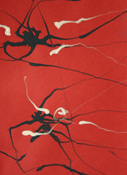 With no prior planning, he starts and develops his complex compositions on canvas. He told an interviewer, “I understand myself to be a director of plays.” The plays, such as they are, emerge in the process. . .
With no prior planning, he starts and develops his complex compositions on canvas. He told an interviewer, “I understand myself to be a director of plays.” The plays, such as they are, emerge in the process. . . In terms of narrative content, the work is maddeningly coy—unless you fancy Jungian woolgathering about archetypes and suchlike—but it is so well designed and painted that, once you have started looking, resistance gives way. . .
Rauch tends to use oils as if they were poster paints, flatly—often scumbling, rather than glazing or blending, to modulate tones and colors. The result is a surreptitious richness. The rhetorical potency of oils—sensuous texture, light-drinking color, infinite suggestiveness—strains at a short, taut leash. The constrictive effect strikes me as perverse, but it is certainly original. It also anchors Rauch’s importance as an artist of and for the historical imbroglio of art today. . .
Rauch’s work provides a cultural moment that seeks legitimacy in art with talismans of rhapsodic complacency.
The surprise is that worry-proof conservatism can generate real artistic force. It does so, in Rauch’s art, by finding opportunities, in trumped-up fantasy, for recovering traditional aesthetic capacities of painting. Having nothing to say, he says it ever more marvellously. . .
The more observant you are of erudite allusions in the show (some male figures display particular airs and dress styles of nineteenth-century German Romanticism), the more acute will be your frustration in trying to make sense of it all. If Rauch’s work is nightmarish, as some critics have asserted, the effect pertains not to its dramas but to their mockery of understanding. They are not mysterious, because mysteries imply solutions. Rather, they convey that we may know plenty but our knowledge is useless. There is a highly contemporary sting in this. Today, we are flooded with accurate information—letting us confidently judge the failures and iniquities of political leaders, for instance—and we naturally feel that such clarity must influence events, but it only amplifies our dismay as the world careers from one readily foreseeable disaster to another. Rauch sets us an example of getting used to it. . .
But I think I’ve never seen an excellent painting that is so masochistically cheerless, to the point of revelling in a contemplation of impotence. I would like to despise the artist for this, but his visual poetry is too persuasive. Present-day reality is a lot more like one of his pictures than I wish it were.
Peter Schjeldahl on Neo Rauch at the Met, in the New Yorker June 4, 2007.


